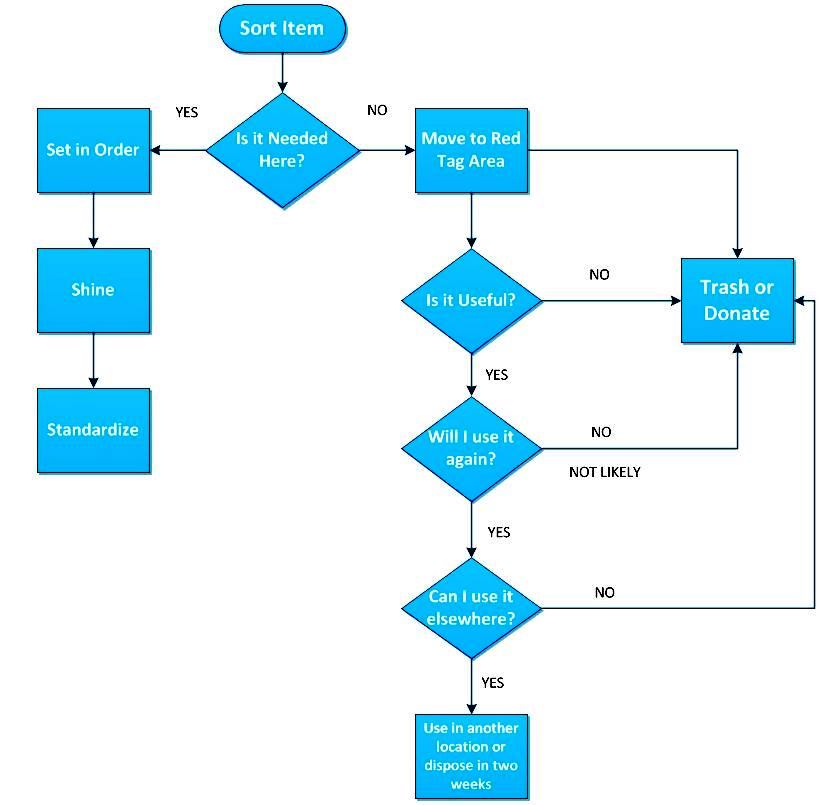With a new year, come new resolutions! Maybe you set a fitness goal. Maybe you want to learn something new. Or maybe you are interested in home organization. If the latter applies to you, then 5S may be the tool to use.
In a previous blog I discussed the Japanese organizational tool, 5S. This tool is often used in manufacturing to improve operations and safety through efficiency, organization, and cleanliness.
Seiri – Sort
Seiton – Straighten
Seiso – Shine
Seiketsu – Standardize
Shitsuke – Sustain
What you may not know, however, is that 5S can be applied anywhere, including your home. Here’s how to use 5S for effective home organization:
It’s always best to divide an area into sections that can be done one by one. For your home this could be room divisions such as: kitchen, garage, etc. or floor divisions: first floor, basement, etc. Then divide each section in smaller areas. Whatever division makes the task less overwhelming is best.
Step 1: Sort.
Pick an area to begin. Start by applying the first S to any closets, cabinets, shelves, drawers, and flat surfaces where things can accumulate. Sort through them all, removing any items which are questionable and place in your designated “red tag” area. This can include misplaced, broken/damaged, unused, or rarely used items, and other types of clutter. Ask yourself the hard questions: Do I need this? How many times have I used this item? What are the chances I will use it again? Be honest with yourself; this is the most difficult part.

Anything that received a “No” should be set aside to donate or be thrown away.
Step 2: Straighten/Set in order.
Now that you’ve removed anything that doesn’t belong, get organized! Think about what items are in that place. Where do you use them most? Are there other items similar to this? Do I use this often enough to keep it out, or should I store it somewhere? It works well to group similar items together such as: cleaning supplies, bakeware, utensils, etc. It also makes sense to have items as close as possible to where you will use them. If you cook with spices a lot, but your spices are kept on the counter opposite the stove, you waste time moving back and forth for what you need. Of course you can’t always have everything close by, but try to prioritize. Designate a location for everything! This is a great time to make use of small containers such as plastic baskets and bins, drawer dividers, and labels! You can divide drawers and closets into segments, group items in containers, and label for easy searching. As best you can, set up the area so that a complete stranger may easily locate items. It helps to make a shopping list of any organizational tool you think you may need during the Sort. Then begin straightening once you have at least the majority of your supplies.
Step 3: Shine.
Once all the clutter has been cleared and reorganized, it’s time to clean. Cleanliness is very important in 5S. You don’t have to clean constantly, but don’t let your hard work go to waste. Give the area a deep clean the first time: dust, wipe down drawers and counters with anti-bacterial wipes, thoroughly sweep and mop where you can, clean appliances, sinks, and knobs; vacuum any surface that can collect dust but isn’t easy to dust. Any surface that can be cleaned should be. It is also a good idea to use protective cleaners such as anti-stain for cloth surfaces such as your cushions.
Step 4: Standardize.
This is the step which may seem strange to you at home. The best way to standardize is to make a list or log of each area. Document the location, the items there, and the condition of the area for checks on organization and cleanliness. If there is “stock” of an item (for example: if you keep 10 rolls of toilet paper or two boxes of trash bags at all times) keep a log of your amount and have a “reorder” point at which you add more to your shopping list. Excel works best for lists like these, but hand written logs will also be effective. You can either leave them on a computer or print and place them on the back of cabinet/closet doors or in a small folder in the area for quick reference.
Step 5: Sustain.
Sustaining is the most difficult S to achieve. It is very easy to let the areas relapse into disarray. The best way to sustain your hard work is to regularly check and update your standardized lists for each area. For large areas such as kitchen counters or a bathroom, weekly checks may be necessary. However, most locations in your home work well with monthly or bi-monthly checks. It’s best to set a frequency specific to each area’s needs. Perhaps a storage closet that keeps household goods should be checked more often than a bedside drawer. When you notice the beginning signs of new clutter, re-apply the first 3 S’s. When “inventory” is low, add items to a shopping list. By doing these regular checks you can sustain your hard work indefinitely with minimal effort.
It may sound over the top, but using 5S is a great method to efficiently organize and manage your living space without the hassle of repeated relapse. You will save time and energy eliminating excessive searching, cleaning, and shopping. You may even want to apply it other places!